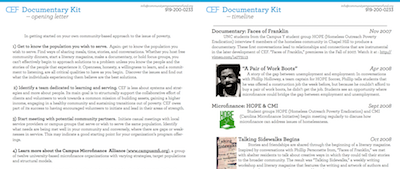Our History and Approach
Our Founding Story
CEF was founded on the idea that small amounts of capital coupled with social support, savings opportunities, financial education, and a positive community can facilitate transitions out of homelessness.
A group of students, shelter residents, faculty, and community members in Chapel Hill launched the Community Empowerment Fund in 2009 to address the systemic financial barriers faced by individuals experiencing homelessness and poverty.
CEF was built through relationships between students, community members, and shelter residents in Chapel Hill, North Carolina. Prior to our launch, students working with the UNC Campus Y committee HOPE offered community development and storytelling-based programs that brought students and shelter residents together in meaningful dialogue on a regular basis. Students began to build relationships with members of the homeless community through projects such as Talking Sidewalks, HOPE Gardens, and Community Dinners.
Through these relationships, HOPE volunteers learned that many individuals in transitional housing simply lacked small amounts of capital to get on the path toward self-sufficiency–as little as $60 for a pair of work boots or $200 for tools. While social service agencies existed that could meet a portion of these needs through small cash grants, such grants did not address the deeper causes of cyclical and systemic poverty and racism. Sustained support, human capital, community networks, and true empowerment were still lacking. The combination of the need for financial assistance and an assertively supportive community led to the creation of the Community Empowerment Fund-a model of microfinance that develops relationships alongside assets.
From there, HOPE began a partnership with the Carolina Microfinance Initiative (CMI), a fellow Campus Y committee with extensive experience in international microfinance. CMI members traveled abroad to intern with notable Microfinance Institutions and brought the lessons from these experiences back to the UNC campus. In November of 2008, the UNC Law School Center on Poverty, Work, & Opportunity joined the partnership to bring an institutional backing and academic foundation to the group’s work.
With the help of these three partners, CEF launched our pilot in the summer of 2009. Eight student volunteer loan officers and five pilot borrowers worked together to apply, adapt, and refine the CEF approach to domestic microfinance.
CEF started as a micro-loan program, but based on the lessons that we learned during the pilot, CEF grew to offer much more. Today, CEF is a vibrant community that brings Advocates and Members together to set and achieve concrete goals around employment, housing, and financial savings. CEF creates a community of support that empowers Members, offers experiential learning opportunities for Advocates to grow and learn, and uses advocacy and collaboration to address the systemic causes of homelessness and poverty. CEF’s work is grounded in recognition of the detrimental impacts of systemic racism on Black and Brown members of our communities.
Documentary: To Borrow Budget and Save
In the CEF’s first year, when CEF was still primarily a micro-loan program, Rumsen Films followed a group of CEF’s original borrow’s to document their progress alongside the organization and produced a 20-minute film called “To Borrow, Budget and Save”.
2009 Pilot Report
CEF launched in the summer of 2009 with two pilot groups of borrowers and funding from the Office of Undergraduate Research, Carolina Center for Public Service, and APPLES. The results of this pilot have been published and are available for public learning and feedback.
Ongoing Research and Evaluation
Research and constant evaluation are integral to the success of the CEF model—both as a student-run organization and as a financial institution that works with especially vulnerable, financially marginalized populations.
Our Approach
CEF’s strategy combines relationship-based support with financial services that pursue equity. Our model centers on the empowerment of Members–encouraging them to identify their own priorities and access the resources needed to gain housing, employment, and financial stability in order to sustain transitions out of homelessness and poverty.
CEF’s collaborative approach complements existing social services. We are the only organization in Durham and Orange Counties that combines free relationship-based support with targeted financial tools.
Why?
In 2017, the Survey of Consumer Finances released data showing that the difference in median wealth between Black and white families was striking, $17,600 compared to $171,000–meaning Black families’ median net worth is about 10% of white families (Dettling et al., 2017). Wealth “is the most complete measure of a family’s future economic well-being” (Hanks et al., 2018). Unlike income, wealth refers to assets that may be passed down from one generation to another. Less wealth provides fewer opportunities for upward mobility and fewer chances to build or pass on assets. The racial wealth gap persists regardless of a households’ education or income (Hanks et al., 2018). This is due to persistent housing and labor market discrimination and segregation that have prevented Black Americans from acquiring property, owning businesses, or making investments for over 400 years (Hanks et al., 2018). In addition to these stifling statistics, a 2018 report by the Federal Reserve found that 39% of Americans don’t have cash on hand for a $400 emergency expense (“Report on Economic Well-Being,” 2018). And, according to 2016 Federal Reserve data, Black Americans are more likely to be underpaid, less likely to have adequate savings, and less likely to have sufficient financial resources to respond to an emergency than their white counterparts, making them more likely to go into debt (“Survey of Consumer Finances,” 2018).
The solutions to this challenge must take place on both a systemic and individual level. Access to financial services can help Black and low-income households build and transfer wealth over time. Access to affordable housing also helps families build wealth, enabling them to afford daily essentials and set aside savings.
CEF believes that access to high-quality affordable financial services is a human right for all people, regardless of socioeconomic status or race. Over the past decade, CEF has proven that combining consistent, person-centered support with targeted financial services can make savings and financial well-being possible for everyone.
Complicated policies and fees along with negative perceptions discourage people from using banks–despite the statistics that show they can actually save people money (“2015 FDIC National Survey,” 2016). In an FDIC survey, Black and Hispanic households were much more likely to report that they felt that banks were not interested in serving them (“2015 FDIC National Survey,” 2016). Unbanked households often rely on exploitative financial services like money orders, check-cashing services, payday loans, rent-to-own agreements, or pawn shops to get access to cash and pay bills. These services are low-quality and unaffordable. In 2008, the Brookings Institution found that a full-time worker could save $40,000 in their lifetime by relying on a low-cost checking account rather than check-cashing services (Fellowes & Mabanta, 2008). The same worker could generate an additional $360,000 during their career if they were connected to a low-cost exchange-traded fund (Fellowes & Mabanta, 2008). This same report found that moderate and low-income households pay over $8 billion in fees to non-bank check-cashing and short-term loan providers in order to have their basic financial services met (Fellowes & Mabanta, 2008).
Access to high-quality affordable financial services can enhance the quality of life and economic productivity of low-income households. Low-income households often have small unpredictable incomes that can vary significantly in periods of unemployment, financial hardship, illness, or due to seasonal employment. Services like savings, credit, and education can help smooth these income fluctuations and provide these individuals with access to past or future income. For example, having savings can ensure financial stability during difficult periods. Through credit, families can access funds in the short-term they may not be currently able to self-generate through income, but will be able to pay off over the long-term with future income. Finally, financial education gives individuals the skills they need to successfully utilize financial services to reach their goals. Above all, individuals need high-quality affordable financial services to realize their personal goals.
An
- In 2017, an estimated 6.5% of U.S. households, approximately 8.4 million, were unbanked
- 5.8% of NC households are unbanked
- 14% of Hispanic households are unbanked nationwide
- 12.4% of African American NC households are unbanked, compared to 16.9% nationwide
*In general, CEF uses APA grammar rules in our writing. The APA says that the names of race and ethnic identities should be capitalized, as they are proper nouns. CEF is intentionally leaving “white” (when referring to a racial identity) lower-cased. We recognize that by capitalizing words we are giving them power and we do not want to encourage white power in any way. Unlike the Associated Press’s (AP) explanation for why they are choosing to lower-case “white,” we want to be clear that we believe white people do have a shared experience–that is one of privilege. We also believe that undoing racism is the responsibility of white people and worry that implying that white people do not have a shared experience (as the AP does) is a dangerous tactic that is aimed at discounting the responsibility that white people have in undoing racism and white supremacist culture. Ultimately, we know that race is a construct but that racial differences are not. They are real and need to be addressed directly. For any questions or clarifications around CEF’s choice of words please contact ari rosenberg (arir[at]communityef.org).
Data and Quotations are from the following resources:
Banking:
Federal Deposit Insurance Corporation. (2016, October 20). 2015 FDIC National Survey of Unbanked and Underbanked Households. https://www.fdic.gov/householdsurvey/2015/2015report.pdf
Federal Deposit Insurance Corporation. (2018, October). 2017 FDIC National Survey of Unbanked and Underbanked Households. https://www.fdic.gov/householdsurvey/2017/2017report.pdf
Federal Deposit Insurance Corporation. (2018, October). 2017 Survey Results for North Carolina. Economic Inclusion. https://economicinclusion.gov/surveys/place-data.html?where=North_Carolina&when=2017
Federal Deposit Insurance Corporation. (2018, October). Unbanked and Underbanked for North Carolina, 2017 by Selected Households Characteristics. Economic Inclusion. https://economicinclusion.gov/surveys/2017household/documents/tabular-results/2017_banking_status_North_Carolina.pdf
Fellowes, M. & Mabanta, M. (2008, January 22). Banking on Wealth: America’s New Retail Banking Infrastructure and Its Wealth-Building Potential. Brookings. https://www.brookings.edu/research/banking-on-wealth-americas-new-retail-banking-infrastructure-and-its-wealth-building-potential/
North Carolina County Economic Snapshots:
Budget and Tax Center. (2020, May 12). County Economic Snapshots 2020. North Carolina Justice Center. https://www.ncjustice.org/publications/county-economic-snapshots-2020/
The Racial Wealth Gap:
Dettling, L., Hsu, J., Jacobs, L., Moore, K. & Thompson, J. (2017, September 27). Recent Trends in Wealth-Holding by Race and Ethnicity: Evidence from the Survey of Consumer Finances. The Federal Reserve. https://www.federalreserve.gov/econres/notes/feds-notes/recent-trends-in-wealth-holding-by-race-and-ethnicity-evidence-from-the-survey-of-consumer-finances-20170927.htm
Federal Reserve System. (2019, May 28). Report on the Economic Well-Being of U.S. Households in 2018 – May 2019. https://www.federalreserve.gov/publications/2019-economic-well-being-of-us-households-in-2018-dealing-with-unexpected-expenses.htm
Federal Reserve System. (2018, July 23). Survey of Consumer Finance. https://www.federalreserve.gov/econres/scfindex.htm
Hanks, A., Solomon, D., & Weller, C. (2018, February 21). Systematic Inequality: How America’s Structural Racism Helped Create the Black-White Wealth Gap. Center for American Progress. https://www.americanprogress.org/issues/race/reports/2018/02/21/447051/systematic-inequality/



